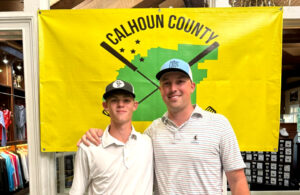Ready to show out
- Updated: September 11, 2022
Cider Ridge, SKCC officials pleased with the way the new bermuda greens at the Oxford course have come in, just in time for the Classic
By Al Muskewitz
East Alabama Sports Today
OXFORD – Cory Etter bent way down on the first green at Cider Ridge Golf Club, ran his hand over the green carpet under his feet and flashed a satisfied smile. He knows it’s the greens the golfers are coming to see to forget about life for a while.
For the past 12 weeks, Etter and Cider Ridge have been in a race with Mother Nature to get their newly installed TifEagle Bermuda greens established and flourishing in time for the Sunny King Charity Classic that gets underway Friday.
More than 200 two-man teams will converge on the course over the weekend – not including the midweek practice rounds – and the operators of the Oxford course have kept their fingers crossed that everything will goes according to plan.
“I really wasn’t worried,” Etter said. “I guess if there was one it was time. You want it get grown in, you want to get it to where people can play again. I would say the weather was pretty good this year, pretty good growing weather. From the time the sprigs went down to the day we opened ,it was 11 weeks and a day.
“We were shooting for 8 to 10 weeks, but we knew if we had 12 weeks that would give us the time.”
Since the spring of 2011, Cider Ridge had been the only course in Calhoun County – and one of the only public-access courses in this part of the state – playing on bent grass greens. It’s a distinction all the course’s operators over the years have worn as a badge of pride, but one that presents its own unique set of challenges.
But those greens have been in place since the day the course opened the first tee in 2002 with no resurfacing other than what takes place during regular maintanence, so they were well past their lifespan. Bent greens typically are resurfaced every eight to 10 years and, Etter said, “for the future of this place to continue to be successful and progress in that way, we have to make the switch.
The new grass also will be applied to a new 40,000-square-foot, 18-hole putting course , the practice putting/chipping area at the site of the current practice green and the nursery green, and they’re adding a short-game area on the right side of the driving range.
There are still some greens on the course that face challenges, particularly 16 and 17 on the back nine and around the edges of the six greens workers returned to their original size, but all 18 greens will be open for play when the Classic begins.
“I didn’t doubt they would be ready,” tournament director Brett Key said. “We all wondered what ready would look like, but we actually went out (last week) and rode around and in my opinion for the time they had to do it I think they looked great.
“We’re happy with the way they look. They’re going to be slow and probably not to everybody’s liking, but for a golf course that redid 18 greens 12 weeks ago … what we saw I don’t think you could expect much better.”
The greens renovation is the biggest piece of an overall enhancement project that’s been in place since Etter and his group have taken over the course some 18 months ago.
While the greens renovation was taking place, crews have been working to clean up neglected or challenged areas around the course in an effort to bring it back to conditions managers remembered in the past and they say the players deserve.
They’ve cut down numerous trees to promote turf growth and enhance the playing experience, reconditioned bunkers, cut through overgrowth, reconditioned par-3 tee boxes and, as late as Wednesday afternoon, laid sod in areas that hadn’t seen grass in a long time.
It’s not the first time a course in the Sunny King rotation has made a major greens renovation prior to the tournament.
In 2011, Silver Lakes changed over from bentgrass to Bermuda, a renovation it was considering even before the tornado that ripped through the area that spring cut a wide swath through the course.
In 2007, Anniston Country Club regressed its greens, leading to the latest SKCC start at the time to give the new growth additional time to get established.
“It’s going to be a challenge the first year, it’s going to be tough, but I think people are going to like it; I think they’re going to really like it,” Etter said. “You have a lot of golfers who either really like bent or really like Bermuda. I grew up on bent and I like bent, but from where we’re at, for a public golf course in the middle of Alabama, it’s really not the best thing for it.”
The switch at Cider Ridge is expected to have an impact on scoring. Defending champions Ott and Dalton Chandler set the tournament scamble record last year with an 18-under-par 54, but even with the strongest field in tournament history the number coming out of the Oxford course this year isn’t expected to be nearly that low.
Some are projecting a change of as many as five shots.
New greens traditionally are firm with shots that might normally hit and stay on more established greens bouncing through or running off the back.
Since the TPC Southwind course in Memphis, home of the PGA Tour’s St. Jude Classic, changed from bent to Bermuda there has been a dramatic shift in scoring. When David Toms won there on bent in 2003, he shot 20-under-par. When he repeated the next year on Bermuda, he shot 16-under (but won by six). No one has reached 20-under since.
Scores may have risen, but curiously the greens produced the lowest three-putt percentage and highest percentage of putts made from 5-10 feet (60.5 percent) and 15-25 feet (18.8) on Tour in 2021.
As the changes relate to the Sunny King, the scramble stroke average for the 23 teams in the Championship Flight on the bent at Silver Lakes in 2010 was 62.3, but it was 61.3 for 38 teams on the new grass in 2012. Of course, the greens were some six months broken in when they played on them that year.
At ACC, scoring records for the tournament are only posted since 2008, so cumulative figures prior to that are unavailable. But in 2006, winners Jeremy McGatha and Jaylon Ellison shot a best-ball 62 at ACC and 2007 winners Randy Reaves and Gary Wigington shot 60 on the new greens in 2008 that were only a couple week’s old.
The top 10 teams on the leaderboard coming out of Cider Ridge on the way to Championship Sunday last year averaged 58.7; the eventual top five averaged 58.2. In the past four Classics (they canceled in 2020), the entire Championship Flight averaged 63.1, 61.8, 60.6 and 63.0 there.
“Some of these guys hit it so close, it doesn’t matter, but overall I do expect (the scores) to be higher,” Key said.
“This course was built for bent grass,” Cider Ridge director of golf Jammie Lett said. “You can see how the greens were built; they were meant to take a shot, they are elevated. Bermuda typically is going to be firmer surface. They will soften a little over time, but that’s a two- or three-year process.”
Until then, the players wish the tournament and the course luck. Those who have been on the new greens already have been surprised at their relative softness, but they still must be cautious with the way they play them.









You must be logged in to post a comment Login